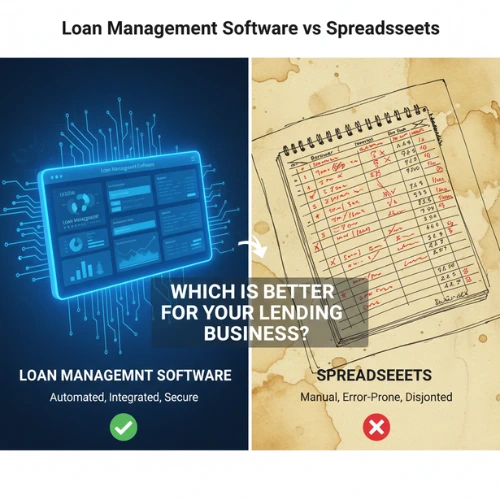
Discover the pros and cons of Loan Management Software vs Spreadsheets for lending businesses. Learn why software is more efficient, secure, and scalable than Excel for managing loans, borrowers, and repayments.
When running a lending business, whether you’re an NBFC, microfinance institution, or cooperative society, managing customer loans effectively is the backbone of success. For many small lenders, spreadsheets like Excel or Google Sheets become the go-to tool for tracking payments, due dates, and borrower details. At the same time, growing lenders realize the importance of loan management software for streamlining operations, automating EMI calculations, and ensuring compliance.
So, the big question arises: Loan Management Software vs Spreadsheets — which truly serves your business better? This guide will break down the differences, highlight advantages and disadvantages, and help you take an informed decision about the future of loan management in your organization.
Why Loan Management Matters in the First Place
Loan businesses deal with sensitive financial data, repayment schedules, and customer trust. When managed properly, the right system reduces defaults, improves repayment efficiency, and ensures accurate records. Poor management, on the other hand, can lead to missed collections, errors in calculations, and even compliance violations.
That’s why choosing the right tool — loan management software or spreadsheets — isn’t just about convenience, but about business growth and long-term sustainability.
The Case for Using Spreadsheets

Why Spreadsheets Became Popular
Spreadsheets like Microsoft Excel or Google Sheets are widely accessible, often free, and easy to use at a basic level. For small lenders or startups just beginning operations, spreadsheets offer a simple solution to record data like borrower names, loan amounts, interest rates, and repayment dates.
Benefits of Spreadsheets
- Low Cost: Excel or Google Sheets involves little to no investment.
- Accessibility: Most team members already have basic knowledge of spreadsheets.
- Customization: You can create custom formulas, pivot tables, and charts to track data.
- Offline & Online Options: Excel works offline; Google Sheets works across devices online.
Limitations of Spreadsheets for Loan Management
- Human Errors: One wrong formula can throw off the entire EMI or repayment schedule.
- Lack of Automation: You need to manually update repayment status.
- Scalability Issues: As your customer base grows, spreadsheets become bulky and slow.
- No Compliance Features: Spreadsheets don’t provide audit trails or regulatory safeguards.
- Data Security Risks: Spreadsheets shared across emails or drives are vulnerable to misuse and breaches.
Spreadsheets are fine for a very small setup, but as loans increase, dependency on them becomes risky.
The Case for Loan Management Software

Why Software Is the Modern Solution
Loan management software (LMS) is purpose-built for the lending industry. It automates collections, sends repayment reminders, calculates interest accurately, and provides detailed borrower histories. Most importantly, it is designed to scale as your business expands.
Key Benefits of Loan Management Software
- Automation of Processes: No need to manually track EMI dates; software auto-sends reminders.
- Error-Free Calculations: Interest, penalty, and EMI are calculated with 100% accuracy.
- Compliance Ready: Provides audit trails, KYC documentation, and regulatory reporting.
- Data Security: Advanced encryption protects sensitive borrower information.
- Scalability: Whether you have 100 or 10,000 borrowers, the system handles large volumes easily.
- Advanced Analytics: Track overdue loans, generate repayment reports, and forecast cash flow.
- Integration with Digital Payments: Accept repayments via UPI, net banking, or debit cards.
When Loan Software Becomes Essential
- Growing customer base across multiple regions.
- Need for faster collections without manual data entry.
- Requirement to maintain compliance with RBI guidelines.
- Desire to switch from paper-based and spreadsheet-based systems to centralized digital records.
Loan Management Software vs Spreadsheets: A Direct Comparison
| Feature | Loan Management Software | Spreadsheets (Excel/Google Sheets) |
| Cost | Paid (subscription/licensed model) | Mostly free or low cost |
| Ease of Use | User-friendly dashboards, training needed | Easy for basic record keeping |
| Automation | High – auto reminders, EMI tracking | None – manual updating required |
| Scalability | Excellent – handles thousands of accounts | Poor – slows down as data grows |
| Error Margin | Very low – automated formulas | High – prone to miscalculations |
| Compliance & Security | Strong audit trails, encryption | Weak – no in-built compliance features |
| Reporting & Analytics | Advanced loan portfolio reports | Limited charts and graphs |
| Data Backup | Cloud-based secure storage | Manual backups required |
It’s clear that while spreadsheets are handy for startups or individual lenders, loan management software is the best option for scaling, securing, and growing a professional lending business.
Common Questions Lenders Ask
Q. Can I use both spreadsheets and loan management software together?
Yes, some businesses continue using spreadsheets for small internal tasks while moving their primary loan tracking to software. Over time, most switch fully to software for efficiency.
Q. Is loan management software expensive?
Not necessarily. Many vendors offer SaaS-based pricing where you only pay for the number of active users or loans. In reality, the time and money saved on errors and late repayments outweigh the subscription cost.
Q. Is switching from spreadsheets to loan software difficult?
Good software providers offer data migration support to transfer all your existing records safely from Excel to the system. Training modules also make adoption easier for your team.
Final Verdict: Which Should You Choose?
If you’re just starting with a handful of borrowers, a spreadsheet could work temporarily. But as your portfolio grows, the risk of errors, inefficiency, and compliance problems increase. In today’s digital-first era, spreadsheets can limit your growth, while loan management software unlocks scalability, automation, and professional operations.
Conclusion and Call-to-Action
At the end of the debate on Loan Management Software vs Spreadsheets, it’s clear that modern lending businesses need software to stay competitive. From automated EMI reminders to secure borrower data management, software brings reliability and growth that spreadsheets simply can’t match.
If you’re looking to streamline your lending process, boost collections, and grow your loan portfolio effortlessly, now is the time to explore advanced loan management software solutions. Don’t let spreadsheets hold your business back — take the next step towards smarter, faster, and more secure lending today.



